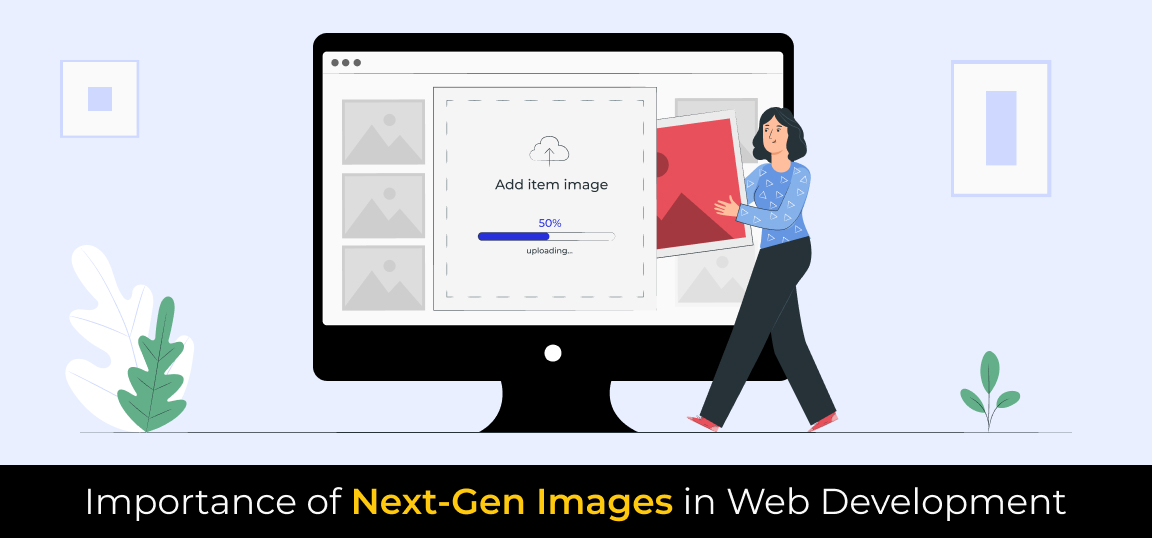
Importance of Next-Gen Images in Web Development
by Ravinder SinghWeb developers are always looking for new techniques to improve the performance of websites because speed and user experience are vitally important for a successful digital presence.
Code Optimization, Minification and Compression, Database Optimization, Responsive Design, and Performance Monitoring and Testing are to name a few such strategies.
In this blog, we are going to elaborate on the application of next-generation image formats as one such strategy, that has experienced significant growth.
Next-gen image formats prioritize high performance by implementing compression techniques that reduce file sizes without compromising image quality. These formats support features like transparency, alpha channel, HDR imaging, animation, and metadata, enabling visually appealing and interactive content.
They maintain backward compatibility with older formats, ensuring smooth transition and adoption. By focusing on these aspects, developers aim to deliver faster image loading times, reduced bandwidth consumption, and improved image quality, enhancing overall performance with these formats.
We’ll explore the significance of next-generation images in web development in this blog post. We’ll look at how image formats like WebP, AVIF, and JPEG 2000 can significantly improve website performance and user experience, which will ultimately lead to higher engagement and conversion rates.
Understanding Next-Gen Image Formats
These formats make use of cutting-edge compression methods to reduce file sizes while preserving high image quality.
Digital images use two compression techniques: lossy and lossless, which reduce file sizes while maintaining image quality. Understanding these differences is crucial for selecting the appropriate method based on specific needs and priorities.
- Lossy: Lossy compression reduces data size by permanently eliminating unnecessary information, resulting in smaller files. However, this reduction sacrifices quality and detail. Lossy image formats like JPEG achieve significant file size reductions by removing less perceptible details.
- Lossless: Lossless compression reduces data size without compromising information or quality. It reconstructs original data perfectly, ensuring the exact replication of decompressed images. Examples include PNG and GIF.
The limitations of older formats like JPEG and PNG have led to the development of the next generation of image file types, or next-gen image formats. Next-generation images aim to address the limitations of older formats, such as:
- Lossy Compression: JPEG uses lossy compression, discarding data to reduce file size, causing loss of quality and details, especially in sharp edges and high contrast areas, and causing compression artefacts.
- File Size and Efficiency: JPEG and PNG formats use different compression methods, resulting in larger file sizes compared to modern formats. PNG preserves image quality but may be less efficient for complex or detailed images, while JPEG sacrifices image quality for smaller file sizes.
- Lack of Advanced Features: Older formats like JPEG and PNG lack advanced features like animation, transparency, and alpha channel support, limiting their usefulness in modern web and multimedia applications.
- Inefficiency for Content: JPEG and PNG are not optimised for all content types, with JPEG suited for photographs and natural scenes but not for text, graphics, or fine details.
WebP:
- When compared to JPEG and PNG, Google’s WebP image format provides better compression. To significantly reduce file sizes without sacrificing visual quality, it uses both lossy and lossless compression. For images with sharp edges or solid color areas, WebP supports transparency and provides better compression efficiency.
AVIF:
- A modern image format based on the AV1 video codec is called AVIF (AV1 Image File Format). It supports both lossy and lossless compression and offers excellent compression performance.
- While maintaining high image quality, AVIF images can achieve significantly smaller file sizes than JPEG images. Due to its capacity to deliver high-quality images with superior compression efficiency, this format is becoming more and more popular.
JPEG 2000:
- With regard to compression efficiency, JPEG 2000 is a flexible image format that outperforms the original JPEG format. It offers better handling of images with complex patterns or high levels of detail and also supports both lossy and lossless compression.
- JPEG 2000 is a good choice for applications where visual fidelity is important because it can produce higher image quality at smaller file sizes.
SVG:
SVG is an XML-based vector image format that uses mathematical equations to define graphics, making it resolution-independent and suitable for responsive design and high-resolution displays. Its file size efficiency is superior to raster image formats like JPEG or PNG, making it ideal for complex shapes and graphics.
SVG supports interactivity and animation, making it a preferred choice for web design and user interface elements. It also supports features like transparency, gradients, filters, and text rendering, making it a popular choice among graphic designers and illustrators.
Benefits of Next-Gen Image Formats:
- Smaller File Sizes: Next-gen image formats use advanced compression techniques, resulting in smaller file sizes, faster load times, and reduced bandwidth consumption, benefiting users and website owners.
- Improved Image Quality: Next-gen image formats maintain high quality compared to older formats due to their use of advanced compression techniques.
- Faster Load Times: Developers can drastically cut page load times by optimizing images with next-gen formats, which will increase user satisfaction, session duration, and engagement. Optimized file sizes improve load times, ensuring an improved user experience, and reducing frustration and abandonment risk on websites.
Studies show that a website load time delay of 100 milliseconds can reduce conversion rates by 7%.
- Mobile Optimization: Websites must be optimized for mobile use, using next-generation image formats to minimize data usage and accelerate loading times. This improves user retention and conversion rates, making mobile browsing smoother, quicker, and more enjoyable.
Next-gen image formats enhance mobile optimization by reducing file sizes, enabling faster loading on devices, improving user experience, and reducing data usage on limited bandwidth and slower connections.
- Cross-Platform Compatibility: Next-gen image formats are compatible with modern web browsers, ensuring consistent display across platforms and devices. They can be used alongside traditional formats and easily integrated into web development workflows.
- Responsive Design and Adaptive Images: Responsive design principles are seamlessly integrated with next-generation images. Developers can deliver images that are specifically suited to the device’s capabilities, such as the screen size, pixel density, and network circumstances, with next-generation images. With this adaptive strategy, users are guaranteed to receive the best image format for their device, maximizing visual quality and reducing needless data usage.
- SEO Benefits: Website performance significantly impacts search engine rankings. Google considers page load times, and using next-generation images in Google PageSpeed Insights reports can improve SEO efforts. Faster load times, lower bounce rates, and higher user engagement demonstrate a high-quality user experience, boosting website ranking.
Conclusion
Web developers now have a potent tool at their disposal for enhancing the user experience and website performance: next-generation images. These image formats use advanced compression algorithms and smaller file sizes to enable quicker load times, especially on mobile devices. They contribute to a more fluid, adaptive browsing experience and seamlessly integrate with responsive design principles.
Additionally, the enhanced website performance brought on by next-generation images can favorably affect search engine rankings, resulting in an increase in organic traffic. Next-gen image formats must be incorporated into web developers’ workflows as they work to create exceptional digital experiences in order to maintain an advantage in the cutthroat online market.
Are you looking to enhance your website’s performance, user engagement, and visual appeal? We would love to help you. Connect with us at – [email protected]
- About the Author
- Latest Posts
I am a member of Cueblock’s Frontend team.
-
Jiva’s Organic Traffic Growth: 354% Surge in 6 Months | CueForGood
by Nida DanishSummary: Jiva’s efforts to empower smallholder farmers weren’t gaining the digital traction they deserved. With a strategic overhaul led by …
Continue reading “Jiva’s Organic Traffic Growth: 354% Surge in 6 Months | CueForGood”
-
What We Learned When We Switched From Disposable Tissues to Reusable Napkins
by Nida DanishAt CueForGood (CFG), we’ve embraced a refreshing change: reusable cloth napkins. While the switch may seem minor, it’s rooted in …
Continue reading “What We Learned When We Switched From Disposable Tissues to Reusable Napkins”
-
Of Light, Laughter & Transformation: Diwali 2024 at Cue For Good
by Nida Danish
On any given day, walking into the Cue For Good office feels like stepping into a space with heart. It’s …
Continue reading “Of Light, Laughter & Transformation: Diwali 2024 at Cue For Good”
-
Why PHP Still Matters in 2024: A Look at Its Continued Relevance
by Girish TiwariAt its peak in the early 2010s, PHP powered the majority of websites globally, including major platforms like Facebook and …
Continue reading “Why PHP Still Matters in 2024: A Look at Its Continued Relevance”
-
How Meta’s New Holiday Ad Features Can Transform Your Business This Season
by Charanjeev SinghThis year, Tapcart’s 2024 BFCM Consumer Trends Report suggests that nearly 60% of shoppers kick off their holiday shopping in …
Continue reading “How Meta’s New Holiday Ad Features Can Transform Your Business This Season”
-
Cue For Good’s Journey at the B Corp Festival 2024: Exploring Louder Than Words
by Pancham PrasharOn September 10th and 11th, 2024, I had the incredible experience at the “Louder Than Words” B Corp Festival, held …
Continue reading “Cue For Good’s Journey at the B Corp Festival 2024: Exploring Louder Than Words”








